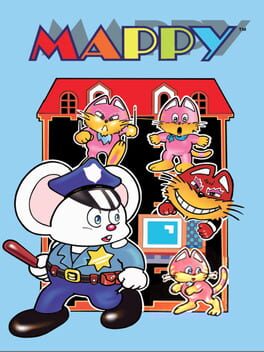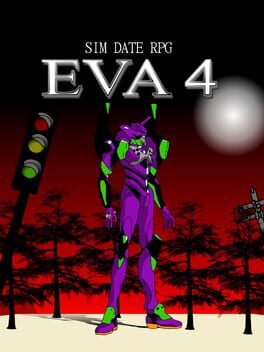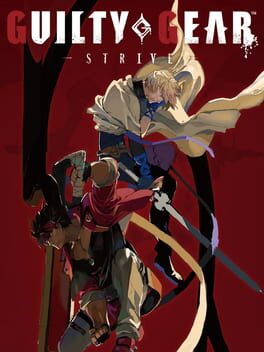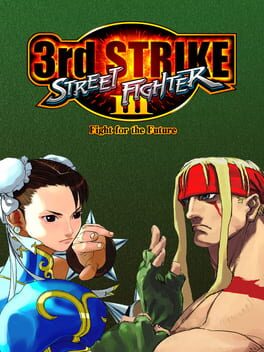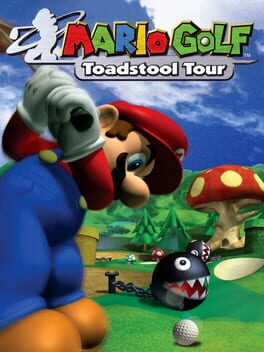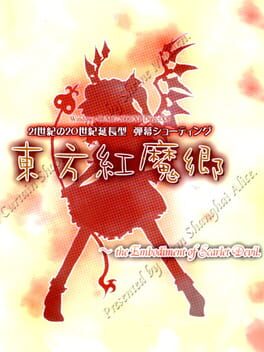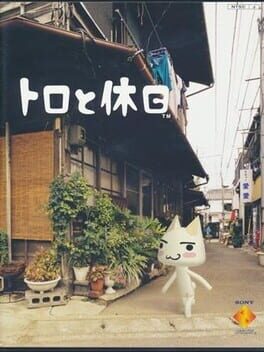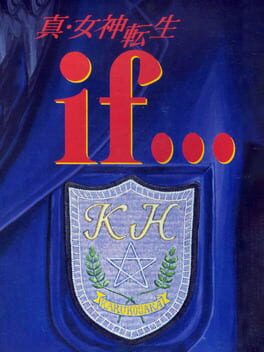Local_Winner
1983
2003
I was a tiny wain when this first emerged onto the internet and now I am a big large oaf who has become inextricably drawn to it. Why are videogame preservationists wasting their time on Atari 2600 shovelware when this, the most culturally impactful game of the early 2000s, is left to the turning of the tides?
2001
Many of the reviews praising this game have outlined it's remarkably unique and stylish aesthetics, so let's instead discuss the competitive integrity and value of Tekken 4 from a meta game perspective.
Typically, my fighting game reviews only explore the nitty gritty of the competitive metagame when I have reason to believe there are systems within the game that prevent it from allowing dynamic and nuanced competition. Those who know me would likely assume that Tekken 4 has a meta that's not particularly to my taste, with system mechanics that put aggression to the forefront and that neuter one of my favourite aspects of the series: it's movement. To my surprise, T4 has a lot going for it competitively and the assessment that the game is defined purely by jab into jab vs jab into sidestep undercuts what we actually observed during its competitive heyday. I'd like to get into some detailed specifics of things I really like that are unique to T4 and only T4, so let's get into it.
Let us start with the cast of T4, specifically let's look at the big three who defined the metagame in an almost rock, paper, scissors style. Jin had the best matchup spread in the game with an all-rounder type tool kit that afforded him everything except movement. Steve was an aggressive anti-meta but still meta option. His great matchup against Jin allowed his less strong matchups elsewhere to not matter as much because so many competitors were naturally drawn to Jin. Nina completely shuts down Steve's options, but doesn't have as strong a matchup with Jin. She's the only character in the game with good backwards movement thanks to Hayashida step and this level of evasion gives her the ability to play as a defensive character who can transition to offense with lockdown from her ivory cutter. Yes, these three define a not completely solvable meta state that, to me, is genius. Now with any metagame, it's not perfect. People will tend to skew towards whatever has the most consistency and the game's mechanics are a large part in determining that. Due to this, much like in every other game, there is still a hierarchical order and the values of rock, paper and scissors respectively are not perfectly equal. That being said, there are more characters beyond the top three, and what's nice about T4 is there is practically no character who feels redundant in their inclusion.
Xiaoyu, Paul, Heihachi, the almost entirely overhauled Kazuya, Marduk. Not only does every character in T4 play pretty wildly different, they all play almost entirely different from their entries in other Tekken titles. I've seen many T4 analyses where some broad comparisons to the original Tekken Tag Tournament have been made that fail to understand that "different" is not necessarily "bad".
A common criticism is that whiff punishment is practically absent in T4. Not only does this statement on a surface level seem a disservice, assessing match footage reveals its not even true. Creating space is certainly not as safe or as easy as it was in TTT and while this does make the game more offensive overall, it also means that characters do not rely on the same hit and run strategies of the past, in which many characters would not opt to be proactive in neutral, as it was too high risk. Kazuya, while stripped of much of his defensive presence, is granted highly rewarding counter hit options in the form of his df2 and new EWGF. He still plays the spacing game and can turtle, but he must adapt to close in when he can afford to press his advantage. I'm not trying to argue T4 has more depth in the ebb and flow of character gameplans than TTT, simply that it is very different and while the meta is rather centralized in both games, I feel that there's more variety at the highest level of play from T4 whereas in TTT, as much as I love it, is really only super fascinating at a high level if you like watching lots of risk mitigation and capitalising on opponent's mistakes.
So then, we know that T4 has variety, but what makes that variety actually good and not just a large selection of differing but boring options?
Let's start with a universal change that deepend the game. The 1 break wallpush being so difficult to break and most other throws being easier than TTT creates exceptional mind games at the wall. The low risk option, which also happens to be quite rewarding for a good chunk of characters, is to wallpush at the wall. This means that players are more prepared to break 1 throws at the wall and they have to be very quick about it given the tiny window wallpush has. With this in mind, they aren't likely going to be expecting your 2 and 1+2 throws near the wall, which creates exceptional mindgames for a lot of the cast. Characters like Nina with super damaging multithrows thrive off of this type of conditioning. It is legitimately my favourite throw system in the entire series. Throws have always been an aspect of Tekken I have found needs some refinement and it's a shame they stepped away from this system because it really is near perfect.
There are some moves that people consider "broken" that actually open up the meta to new options rather than solved gamestates, as the moniker "broken" would imply. For example, Jin's just frame laser scraper unblockable.
When getting hit by the string, some characters can use a hopkick to make themselves airborne so it won't connect properly, stopping the opponent from getting a proper launch. The decision making here depends on if you believe your opponent is good enough to hit the unblockable. You can side step and get a punish if they're too slow or block the third hit if they're too fast but if you go for a hopkick to mitigate the damage from the just frame and they don't land it, you'll be getting hit when it could have been your opportunity to go on the offensive. Much like parry baiting in 3rd Strike, there's a level of skill checking at play. Of course, at the highest level this wouldn't happen, right? Match footage from SBO 2004 showed numerous Jin's missing their unblockable and in response? Not many hopkick escapes. TomHilfiger vs Jr.Lime? TomHilfiger goes for hopkicks even though Jr.Lime misses some unblockables because he knows when it's too risky to let the unblockable connect.
We must now address the elephant in the room: wall touch of deaths. "The horror!" I hear you wail. "Infinites and ToDs are just unacceptable!" Surely no competitive game can have something like that! Oh wait, MvC2, UMvC3, 3rd strike, Alpha 3, Tekken 5, Tekken 7, etc, etc, etc. Now I'm being hyperbolic to illustrate a point, but let's look more closely at the wall ToDs in T4 before we jump to conclusions. Depending on the era of T4 you watch, certain rules were in effect regarding what stages were tournament legal. While lots of characters can get huge unscaled damage in the corners of some stages, there's not a huge amount of footage of this occuring in tournaments where said stages were legal. Perhaps it was because competitors knew that playing too passively and allowing themselves to be pushed to the wall or corner would result in their death and so, they used the strengths of pokes or evasion when the opponent's offense became too predictable to keep the opponent from continuosly pushing them back. The only character who's gameplan actually revolves around going for a ToD is Lee, because of his infinite wall combo on the arena stage, which was a go to for events that wanted to limit what stages were allowed. This makes his gameplan similar to that of Makoto's touch of stun strategy with SA2 in 3rd Strike. Lee has to struggle for positioning and condition the opponent to do what he wants so he can finish out the round. Might I remind the reader that additionally, a game of Tekken is a best of 5 rounds. If these ToDs were so present and game disrupting that they destroyed all competitive integrity, surely there would be tournament footage of these ToDs occuring numerous rounds and closing out numerous games in a high level top 16. I urge those who believe the wall ToDs ruin this game to find such footage. I'd love to see it.
To me, T4 and TTT are a superb pairing. What T4 lacks TTT has, and what TTT lacks T4 has. They compliment each other with their differences and it's what made their pairing together during the early 2000's competitive Tekken events so flavourful and diverse.
Many small decisions impacted the game in truly meaningful ways not directly observable. I highly encourage those that are interested in T4 to watch old Tougeki and Evolution footage, as I believe much of it illustrates many of the positions I have argued throughout this review. Additionally, the TomHilfiger vs. Jr.Lime replay commentated by Aris can give context to what competitive Tekken was like back then. I envy an era where competition happened purely for the love of the game, when there was no money, when play occured because the games were good and communities wanted to support games for being good.
Typically, my fighting game reviews only explore the nitty gritty of the competitive metagame when I have reason to believe there are systems within the game that prevent it from allowing dynamic and nuanced competition. Those who know me would likely assume that Tekken 4 has a meta that's not particularly to my taste, with system mechanics that put aggression to the forefront and that neuter one of my favourite aspects of the series: it's movement. To my surprise, T4 has a lot going for it competitively and the assessment that the game is defined purely by jab into jab vs jab into sidestep undercuts what we actually observed during its competitive heyday. I'd like to get into some detailed specifics of things I really like that are unique to T4 and only T4, so let's get into it.
Let us start with the cast of T4, specifically let's look at the big three who defined the metagame in an almost rock, paper, scissors style. Jin had the best matchup spread in the game with an all-rounder type tool kit that afforded him everything except movement. Steve was an aggressive anti-meta but still meta option. His great matchup against Jin allowed his less strong matchups elsewhere to not matter as much because so many competitors were naturally drawn to Jin. Nina completely shuts down Steve's options, but doesn't have as strong a matchup with Jin. She's the only character in the game with good backwards movement thanks to Hayashida step and this level of evasion gives her the ability to play as a defensive character who can transition to offense with lockdown from her ivory cutter. Yes, these three define a not completely solvable meta state that, to me, is genius. Now with any metagame, it's not perfect. People will tend to skew towards whatever has the most consistency and the game's mechanics are a large part in determining that. Due to this, much like in every other game, there is still a hierarchical order and the values of rock, paper and scissors respectively are not perfectly equal. That being said, there are more characters beyond the top three, and what's nice about T4 is there is practically no character who feels redundant in their inclusion.
Xiaoyu, Paul, Heihachi, the almost entirely overhauled Kazuya, Marduk. Not only does every character in T4 play pretty wildly different, they all play almost entirely different from their entries in other Tekken titles. I've seen many T4 analyses where some broad comparisons to the original Tekken Tag Tournament have been made that fail to understand that "different" is not necessarily "bad".
A common criticism is that whiff punishment is practically absent in T4. Not only does this statement on a surface level seem a disservice, assessing match footage reveals its not even true. Creating space is certainly not as safe or as easy as it was in TTT and while this does make the game more offensive overall, it also means that characters do not rely on the same hit and run strategies of the past, in which many characters would not opt to be proactive in neutral, as it was too high risk. Kazuya, while stripped of much of his defensive presence, is granted highly rewarding counter hit options in the form of his df2 and new EWGF. He still plays the spacing game and can turtle, but he must adapt to close in when he can afford to press his advantage. I'm not trying to argue T4 has more depth in the ebb and flow of character gameplans than TTT, simply that it is very different and while the meta is rather centralized in both games, I feel that there's more variety at the highest level of play from T4 whereas in TTT, as much as I love it, is really only super fascinating at a high level if you like watching lots of risk mitigation and capitalising on opponent's mistakes.
So then, we know that T4 has variety, but what makes that variety actually good and not just a large selection of differing but boring options?
Let's start with a universal change that deepend the game. The 1 break wallpush being so difficult to break and most other throws being easier than TTT creates exceptional mind games at the wall. The low risk option, which also happens to be quite rewarding for a good chunk of characters, is to wallpush at the wall. This means that players are more prepared to break 1 throws at the wall and they have to be very quick about it given the tiny window wallpush has. With this in mind, they aren't likely going to be expecting your 2 and 1+2 throws near the wall, which creates exceptional mindgames for a lot of the cast. Characters like Nina with super damaging multithrows thrive off of this type of conditioning. It is legitimately my favourite throw system in the entire series. Throws have always been an aspect of Tekken I have found needs some refinement and it's a shame they stepped away from this system because it really is near perfect.
There are some moves that people consider "broken" that actually open up the meta to new options rather than solved gamestates, as the moniker "broken" would imply. For example, Jin's just frame laser scraper unblockable.
When getting hit by the string, some characters can use a hopkick to make themselves airborne so it won't connect properly, stopping the opponent from getting a proper launch. The decision making here depends on if you believe your opponent is good enough to hit the unblockable. You can side step and get a punish if they're too slow or block the third hit if they're too fast but if you go for a hopkick to mitigate the damage from the just frame and they don't land it, you'll be getting hit when it could have been your opportunity to go on the offensive. Much like parry baiting in 3rd Strike, there's a level of skill checking at play. Of course, at the highest level this wouldn't happen, right? Match footage from SBO 2004 showed numerous Jin's missing their unblockable and in response? Not many hopkick escapes. TomHilfiger vs Jr.Lime? TomHilfiger goes for hopkicks even though Jr.Lime misses some unblockables because he knows when it's too risky to let the unblockable connect.
We must now address the elephant in the room: wall touch of deaths. "The horror!" I hear you wail. "Infinites and ToDs are just unacceptable!" Surely no competitive game can have something like that! Oh wait, MvC2, UMvC3, 3rd strike, Alpha 3, Tekken 5, Tekken 7, etc, etc, etc. Now I'm being hyperbolic to illustrate a point, but let's look more closely at the wall ToDs in T4 before we jump to conclusions. Depending on the era of T4 you watch, certain rules were in effect regarding what stages were tournament legal. While lots of characters can get huge unscaled damage in the corners of some stages, there's not a huge amount of footage of this occuring in tournaments where said stages were legal. Perhaps it was because competitors knew that playing too passively and allowing themselves to be pushed to the wall or corner would result in their death and so, they used the strengths of pokes or evasion when the opponent's offense became too predictable to keep the opponent from continuosly pushing them back. The only character who's gameplan actually revolves around going for a ToD is Lee, because of his infinite wall combo on the arena stage, which was a go to for events that wanted to limit what stages were allowed. This makes his gameplan similar to that of Makoto's touch of stun strategy with SA2 in 3rd Strike. Lee has to struggle for positioning and condition the opponent to do what he wants so he can finish out the round. Might I remind the reader that additionally, a game of Tekken is a best of 5 rounds. If these ToDs were so present and game disrupting that they destroyed all competitive integrity, surely there would be tournament footage of these ToDs occuring numerous rounds and closing out numerous games in a high level top 16. I urge those who believe the wall ToDs ruin this game to find such footage. I'd love to see it.
To me, T4 and TTT are a superb pairing. What T4 lacks TTT has, and what TTT lacks T4 has. They compliment each other with their differences and it's what made their pairing together during the early 2000's competitive Tekken events so flavourful and diverse.
Many small decisions impacted the game in truly meaningful ways not directly observable. I highly encourage those that are interested in T4 to watch old Tougeki and Evolution footage, as I believe much of it illustrates many of the positions I have argued throughout this review. Additionally, the TomHilfiger vs. Jr.Lime replay commentated by Aris can give context to what competitive Tekken was like back then. I envy an era where competition happened purely for the love of the game, when there was no money, when play occured because the games were good and communities wanted to support games for being good.
2021
When you boot up a fighting game, what do you want to get out of it? It could be a simple distraction, it could be to socialize with friends, it could be so you can larp as some kind of videogame wizard on a journey to fighting game perfection (that seems to be increasingly and concerningly popular). For me, when I boot up a fighting game, I want two things out of it. I want a skill based competition and I want to experience moments of player expression. When I say "player expression" I don't mean finding an opponent who plays a character in a way that completely disregards the typical values of their tool kit, rather I want a communication between players of what their habits are, what they are good at and what they are bad at. A good fighting game, to me, allows for a player who observes these habits, the strengths and weaknesses of what their opponent can and cannot do, to take advantage of these observations. You can probably assert from my score, that I don't believe strive does this well.
Before I had spent a significant amount of time examining GG as a series very, very closely in order to determine what it was about it that simply did not 'click' with me, one of my earliest negative observations I made when I was playing accent core was the fact that it felt like I was doing everything on autopilot once I got to a certain level. It felt as if I was winning matches because I had completely committed to a working formula and I was losing matches because I had either broken the formula or was simply outplayed in neutral and then got mixed over and over to death. Not really an experience rich with 'player expression' as I had described earlier. What was more shocking to me, was the fact that when I sought to improve, while I was met with the usual process of assessing matchup knowledge and optimizing certain combo routes and setplay, at the highest possible level of play the overall gameplay loop was still identical. Win neutral, force situations and suffocate the opponent as long as possible. No reactive gameplay allowed. Passivity is never correct, never optimal. You will play aggressively and only aggressively because the risk reward is skewed to only one style of play across almost the entire roster.
Almost the entire roster. Pardon this upcoming tangent, but I'm a big fan of Street Fighter Alpha 2. One of my favourite aspects of A2 is how alpha counters are balanced. To those not familiar with this fabulous game, when in blockstun every character can input a 412 motion (back, down back, down) followed by a punch or kick to counter attack for 1 bar of meter when you would normally be forced to continue blocking. Accent core has a character who has defensive options that are heavily inspired by this mechanic. They feature a variety of creative tools and option selects from these alpha counters, lending them an overall playstyle that shifts between defense and offense that is unlike the rest of the cast (though to be completely honest, the offensive part of the gameplan is the same kind of aforementioned looping suffocation I'm not particularly fond of). Fans of strive who have not played accent core may even be shocked to hear that this character is in fact in strive! Though in a form almost entirely unrecognizable.
Baiken may be the best example of how this game seems to primarily kneel to the whims of the consumers rather than the players and competitors.
"This character is popular and will sell DLC on aesthetics alone, but in the past, people who do not actually put in the effort to play her complain that her defensive playstyle and unintuitive means of opening up the opponent are not fun. Thus, we must bow to the majority who want to play her purely based on aesthetics, isolating fans of her original playstyle, even though it will mean we reduce her kit to options that make her gameplan almost completely homogeneous with the existing roster."
It really appears a LOT of the decision making, beyond this one example, was a process based on selling copies rather than fulfilling a vision. Fluff has superceded substance and strive has chosen to reject the few things that made past guilty gears truly unique in favour of broad appeal. Neuter tool kits, homogenize the cast and leave nothing up to the imagination of the player. While I felt that previous entries left little room for nuanced gameplay, this is a whole new level of monotony.
Perhaps a virtue of the coin-op days was the fact that fighting games had to be designed with intention regarding the core gameplay because if all the game could offer was visual finesse, the consumer would only drop a single quarter on the experience. Now flash is all that's needed to reel in some sorry suckers and get them to spend $100+ on your game, dlc characters, colours and stages. I would certainly know, I bought this game full price on launch with the first dlc pass. They got me. Hook, line & sinker.
I'm not trying to belittle those that enjoy strive, but I do want to understand what exactly the appeal is compared to any of the previous entries. I've still yet to see a positive review of strive that argues for something unique to the experience itself. The closest I've come across is the idea that the game is "easy to pick up" and execute. Is this really a virtue when the gameplay itself is so one note? What's the point of having easy execution if the things you are executing contribute to a gamestate that itself isn't particularly deep?
Typically, I like to end my needlessly long reviews on a somewhat positive note. Either optimism for the future or an appreciation for the things a game has done well. I struggle so much to find anything with strive. I will instead thank you for reading this review, even if you just skimmed. I hope that strive may develop something unique and defining for itself someday.
Before I had spent a significant amount of time examining GG as a series very, very closely in order to determine what it was about it that simply did not 'click' with me, one of my earliest negative observations I made when I was playing accent core was the fact that it felt like I was doing everything on autopilot once I got to a certain level. It felt as if I was winning matches because I had completely committed to a working formula and I was losing matches because I had either broken the formula or was simply outplayed in neutral and then got mixed over and over to death. Not really an experience rich with 'player expression' as I had described earlier. What was more shocking to me, was the fact that when I sought to improve, while I was met with the usual process of assessing matchup knowledge and optimizing certain combo routes and setplay, at the highest possible level of play the overall gameplay loop was still identical. Win neutral, force situations and suffocate the opponent as long as possible. No reactive gameplay allowed. Passivity is never correct, never optimal. You will play aggressively and only aggressively because the risk reward is skewed to only one style of play across almost the entire roster.
Almost the entire roster. Pardon this upcoming tangent, but I'm a big fan of Street Fighter Alpha 2. One of my favourite aspects of A2 is how alpha counters are balanced. To those not familiar with this fabulous game, when in blockstun every character can input a 412 motion (back, down back, down) followed by a punch or kick to counter attack for 1 bar of meter when you would normally be forced to continue blocking. Accent core has a character who has defensive options that are heavily inspired by this mechanic. They feature a variety of creative tools and option selects from these alpha counters, lending them an overall playstyle that shifts between defense and offense that is unlike the rest of the cast (though to be completely honest, the offensive part of the gameplan is the same kind of aforementioned looping suffocation I'm not particularly fond of). Fans of strive who have not played accent core may even be shocked to hear that this character is in fact in strive! Though in a form almost entirely unrecognizable.
Baiken may be the best example of how this game seems to primarily kneel to the whims of the consumers rather than the players and competitors.
"This character is popular and will sell DLC on aesthetics alone, but in the past, people who do not actually put in the effort to play her complain that her defensive playstyle and unintuitive means of opening up the opponent are not fun. Thus, we must bow to the majority who want to play her purely based on aesthetics, isolating fans of her original playstyle, even though it will mean we reduce her kit to options that make her gameplan almost completely homogeneous with the existing roster."
It really appears a LOT of the decision making, beyond this one example, was a process based on selling copies rather than fulfilling a vision. Fluff has superceded substance and strive has chosen to reject the few things that made past guilty gears truly unique in favour of broad appeal. Neuter tool kits, homogenize the cast and leave nothing up to the imagination of the player. While I felt that previous entries left little room for nuanced gameplay, this is a whole new level of monotony.
Perhaps a virtue of the coin-op days was the fact that fighting games had to be designed with intention regarding the core gameplay because if all the game could offer was visual finesse, the consumer would only drop a single quarter on the experience. Now flash is all that's needed to reel in some sorry suckers and get them to spend $100+ on your game, dlc characters, colours and stages. I would certainly know, I bought this game full price on launch with the first dlc pass. They got me. Hook, line & sinker.
I'm not trying to belittle those that enjoy strive, but I do want to understand what exactly the appeal is compared to any of the previous entries. I've still yet to see a positive review of strive that argues for something unique to the experience itself. The closest I've come across is the idea that the game is "easy to pick up" and execute. Is this really a virtue when the gameplay itself is so one note? What's the point of having easy execution if the things you are executing contribute to a gamestate that itself isn't particularly deep?
Typically, I like to end my needlessly long reviews on a somewhat positive note. Either optimism for the future or an appreciation for the things a game has done well. I struggle so much to find anything with strive. I will instead thank you for reading this review, even if you just skimmed. I hope that strive may develop something unique and defining for itself someday.
This game's lasting power is unparalleled. Even ST does not generate the kind of attention this game continues to receive. I constantly see new people getting into this game, some of which have little to no experience in any fighting game. When all the modern, soulless, commercial, consumerist, dogshit fighting games fail, people seem to come back to this game in particular.
You can have issues with it, I have plenty of things I'd like changed in the game. You can call it overrated, it certainly receives a lot of praise. You can even make bizarre, baseless claims with your head up your ass that it's "totally broken" and "is nowhere near as balanced as new fighting games." It will outlast whatever shitty anime game you cling to. It will outlast you, yourself.
We'll never see another fighting game like it.
You can have issues with it, I have plenty of things I'd like changed in the game. You can call it overrated, it certainly receives a lot of praise. You can even make bizarre, baseless claims with your head up your ass that it's "totally broken" and "is nowhere near as balanced as new fighting games." It will outlast whatever shitty anime game you cling to. It will outlast you, yourself.
We'll never see another fighting game like it.
Tossing my review into the unsurprisingly large pile.
Around launch I saw a lot of people saying this game shouldn't be compared to fromsoft's souls titles because it is "nothing like them". The reality is this game has clearly inherited parts of the formula. I cannot neatly discern where the souls inspiration meets the AC inspiration because I haven't played any of the previous AC titles. I have played Bloodborne and a couple of the souls games, and I can comfortably say AC6 is better than all of the ones I've tried. My issue with many of fromsoft's games is their tendency to punish the player for experimentation, to make exploration often unnecessarily risky and to have horrendous difficulty scaling (Bloodborne I think is a perfect example, with everything after the forbidden woods being mindlessly easy). This game has many of the same faults, but it addresses one of them well.
Experimentation essentially IS this game and you are constantly encouraged to continuously try new builds. It is highly rewarding and while there is a degree of centralization in the latter half of the game, it was never to a degree where I felt I could rely on a single build for every mission. I really quite enjoy this aspect of the game.
Exploration is quite limited level to level and there is not much in the way of satisfying rewards for exploration. That being said, I can divert from the objective and not have to worry about losing my souls and having to play a tedious game of fetch to reclaim them. I can waltz wherever I please within a map generally hassle free and it's somewhat of a shame there's no substantial reason to do as such.
This game's difficulty scaling is terrible. The first chapter was the hardest for me and while there were good ups and downs as it generally maintained a moderate level of challenge afterwards, I felt that the majority of the levels (and especially non boss levels) were too easy. Additionally, arena mode was a huge wasted opportunity. As it dawned on me that this mode presented absolutely no challenge I thought to myself "perhaps there will be some sort of arena rush mode where you have to consecutively take out all the challengers?" You know. Something that would be fun or engaging. Where you might have to worry about resource management and play more or less conservatively depending on the foe. But no, there is no such mode. It's the only part of the game where absolutely no experimentation is required.
The PvP is quite fun, though I wish more people played it. I've yet to have a really good back and forth with a player, but it gives me an opportunity to show off my byootiful designs and draining health bars with dual stun needles over and over is still enjoyable in its own way. A matchmaking queue seems like the right approach to increasing the online player count (as well as some weapon balancing).
I feel it's almost not worth mentioning the story. It is possibly one of the most unoriginal, uninspired, generic, predictable stories in a videogame. It is poorly written, poorly acted and poorly delivered. I saw someone mention this is one of the better stories in an AC game. Really hoping that was a joke.
I think this game is alright. At its core (haha) this is a good game with good design ideas. Unfortunately, there are HUGE areas for improvement. Ideally, the next game will deliver on that.
Around launch I saw a lot of people saying this game shouldn't be compared to fromsoft's souls titles because it is "nothing like them". The reality is this game has clearly inherited parts of the formula. I cannot neatly discern where the souls inspiration meets the AC inspiration because I haven't played any of the previous AC titles. I have played Bloodborne and a couple of the souls games, and I can comfortably say AC6 is better than all of the ones I've tried. My issue with many of fromsoft's games is their tendency to punish the player for experimentation, to make exploration often unnecessarily risky and to have horrendous difficulty scaling (Bloodborne I think is a perfect example, with everything after the forbidden woods being mindlessly easy). This game has many of the same faults, but it addresses one of them well.
Experimentation essentially IS this game and you are constantly encouraged to continuously try new builds. It is highly rewarding and while there is a degree of centralization in the latter half of the game, it was never to a degree where I felt I could rely on a single build for every mission. I really quite enjoy this aspect of the game.
Exploration is quite limited level to level and there is not much in the way of satisfying rewards for exploration. That being said, I can divert from the objective and not have to worry about losing my souls and having to play a tedious game of fetch to reclaim them. I can waltz wherever I please within a map generally hassle free and it's somewhat of a shame there's no substantial reason to do as such.
This game's difficulty scaling is terrible. The first chapter was the hardest for me and while there were good ups and downs as it generally maintained a moderate level of challenge afterwards, I felt that the majority of the levels (and especially non boss levels) were too easy. Additionally, arena mode was a huge wasted opportunity. As it dawned on me that this mode presented absolutely no challenge I thought to myself "perhaps there will be some sort of arena rush mode where you have to consecutively take out all the challengers?" You know. Something that would be fun or engaging. Where you might have to worry about resource management and play more or less conservatively depending on the foe. But no, there is no such mode. It's the only part of the game where absolutely no experimentation is required.
The PvP is quite fun, though I wish more people played it. I've yet to have a really good back and forth with a player, but it gives me an opportunity to show off my byootiful designs and draining health bars with dual stun needles over and over is still enjoyable in its own way. A matchmaking queue seems like the right approach to increasing the online player count (as well as some weapon balancing).
I feel it's almost not worth mentioning the story. It is possibly one of the most unoriginal, uninspired, generic, predictable stories in a videogame. It is poorly written, poorly acted and poorly delivered. I saw someone mention this is one of the better stories in an AC game. Really hoping that was a joke.
I think this game is alright. At its core (haha) this is a good game with good design ideas. Unfortunately, there are HUGE areas for improvement. Ideally, the next game will deliver on that.
Fighting game fans have a very limited selection of options and I theorize that many players who invest heavily into their games of choice end up with somewhat of a "player's remorse", in which the time invested in the game doing the unfun portions (labbing, practicing combos and setplay, etc.) creates a cognitive dissonance when the experience of playing the game and having a stronger understanding of it causes the flaws to move to the forefront. Do they admit the game isn't as flawlessly designed as they once thought and accept they feel like they wasted their time trying to get good? Or do they double down and say "because I play this game, it is the best one."? I think many gear fans pick the latter and I don't blame them because much of the contradictory design philosophy is disguised as exactly what these players were drawn to in the first place.
Gear as a series is heavily focused on offense. The entire cast has offensive options that in many other more traditional (aka non-anime) fighting games would break them wide open. To remedy this, gear opts for mechanics like burst, FD, IB and so on to make it so that the incredibly strong offensive options have, what in their design team's mind, is "equally" strong defensive options. I could pick apart why I dislike practically all of gear's defensive mechanics because I think almost all of them could be designed better, but instead let's just take a core principle of game design into account. Offense wins the game. Offense is inherently stronger than defense because you cannot win without AT SOME POINT selecting an offensive option. In this sense, balance of any fighting game is always going to be skewed towards offensive play because that is what determines who wins.
This review could really be for any entry in gear's series because they all suffer from this contradiction. The overtuning of offense creates a game in which you feel out neutral, someone wins and the defender plays RPS until they guess right or react accordingly and then becomes the attacker and does the same to their opponent. When "balance" is discussed in fighting games, rarely is it a discussion of "how strong are offensive options vs defensive?" It's a matter of "how many characters are viable in the metagame?" and this is a shame to me as the former is often more important to the longevity of a game's competitive integrity. Shallow gameplay that skews too far towards offense or defense results in the things fighting game fans hate the most: timer scams, 50/50 to death, no emphasis on neutral, touch of deaths, etc, etc. These games can still be fun and even to some people's taste, but they don't make for deep compelling competition. Skewing that kind of balance centralizes games to a degree that, to me, makes them very boring.
I played gear for a good long time. I came to understand it well enough. I can safely say it isn't for me. I'll still find some of the characters fun, I'll still be able to enjoy this game for what is good about it, but it will never hold a place in my mind as a game that is thoughtfully designed or competitively interesting.
Gear as a series is heavily focused on offense. The entire cast has offensive options that in many other more traditional (aka non-anime) fighting games would break them wide open. To remedy this, gear opts for mechanics like burst, FD, IB and so on to make it so that the incredibly strong offensive options have, what in their design team's mind, is "equally" strong defensive options. I could pick apart why I dislike practically all of gear's defensive mechanics because I think almost all of them could be designed better, but instead let's just take a core principle of game design into account. Offense wins the game. Offense is inherently stronger than defense because you cannot win without AT SOME POINT selecting an offensive option. In this sense, balance of any fighting game is always going to be skewed towards offensive play because that is what determines who wins.
This review could really be for any entry in gear's series because they all suffer from this contradiction. The overtuning of offense creates a game in which you feel out neutral, someone wins and the defender plays RPS until they guess right or react accordingly and then becomes the attacker and does the same to their opponent. When "balance" is discussed in fighting games, rarely is it a discussion of "how strong are offensive options vs defensive?" It's a matter of "how many characters are viable in the metagame?" and this is a shame to me as the former is often more important to the longevity of a game's competitive integrity. Shallow gameplay that skews too far towards offense or defense results in the things fighting game fans hate the most: timer scams, 50/50 to death, no emphasis on neutral, touch of deaths, etc, etc. These games can still be fun and even to some people's taste, but they don't make for deep compelling competition. Skewing that kind of balance centralizes games to a degree that, to me, makes them very boring.
I played gear for a good long time. I came to understand it well enough. I can safely say it isn't for me. I'll still find some of the characters fun, I'll still be able to enjoy this game for what is good about it, but it will never hold a place in my mind as a game that is thoughtfully designed or competitively interesting.
2001
